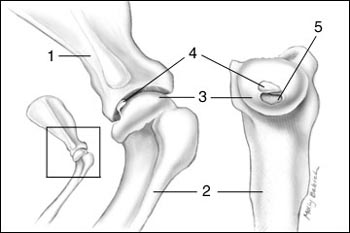Canine
OCD, osteochondrosis, osteochondritis dissecans, shoulder/elbow/stifle dysplasia, joint mice
Dogs, humans, pigs, horses, cattle, chickens, and turkeys.
Osteochondrosis is a disease that affects cartilage formation; the cartilage, due to an abnormal thickening, is unable to receive a normal supply of nutrients from the joint fluid, causing it to become weaker and more susceptible to damage. Cartilage provides a protective gliding layer between the bones in a joint, and when it is injured and lesions form, the dog will experience pain, lameness, and arthritis. Lesions may occur on one or both sides of the body.

- Scapula
- Humerus
- Humeral Head
- Floating Cartilage and Bone
- Detachment Site
In all animals, osteochondrosis can affect many different joints, but in the dog, the most common sites of disease are the shoulder, elbow, stifle or knee joint, and tarsus or hock. Generally, osteochondrosis occurs in young, large to giant breeds, although it is also seen in mixed breeds. The most commonly affected breeds include the German shepherd, golden and Labrador retriever, rottweiler, Great Dane, Bernese mountain dog, and Saint Bernard.
|
|














